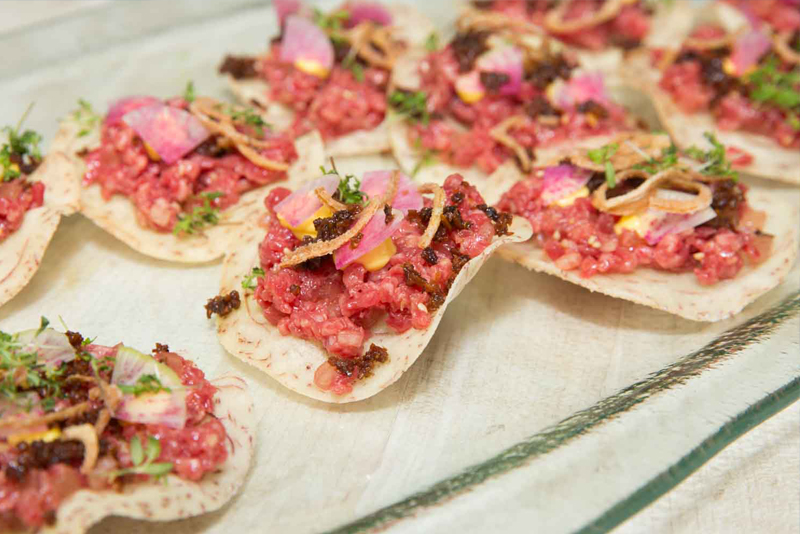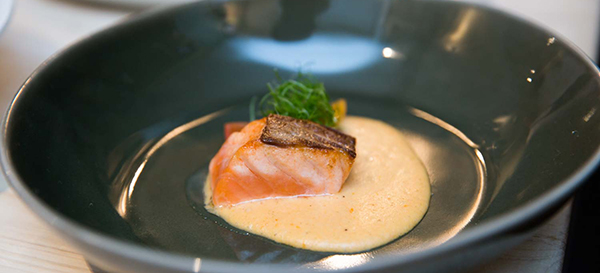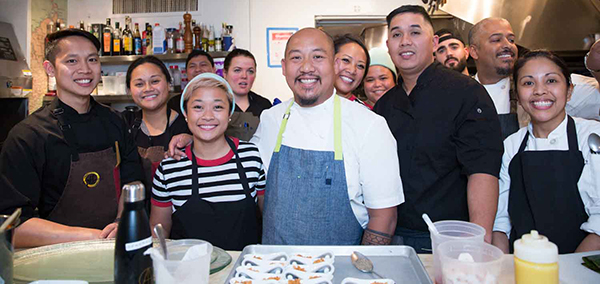Serving Filipino food in America

Wagyu Tartare with Maguindanao Palapa Photos by Alexa Bendek and Starchefs.Com
When I first started doing popup dinner events in the United States two years ago, one of the biggest dilemmas I faced was what kind of Filipino food I would feed the American public.
Cooking traditional, classic Filipino food seemed like the best way to go about it. After all, if indeed Filipino food was “not as popular” as other cuisines at that time, wouldn’t cooking traditional be the best way to educate them?
There were also questions on “modernizing” the recipes or changing the presentation. If I did, would I be straying too far from tradition and therefore not be cooking “real” Filipino food? The other thought was to avoid the “weirder” flavors and concentrate on flavors that were easier to digest, like the adobos, the sinigangs and kinilaws, and avoid the dinuguans and papaitans. That way, Americans could be eased into the cuisine.
When I landed in San Francisco to do my first popup (in collaboration with Filipino Kitchen), I was immediately whisked into the Filipino community, particularly the Pinoys deep into Filipino cultural work.

Salmon Sarciado
Filipino Kitchen helped me I realize how far Filipino food and culture had come. Forget about easing people into the cuisine; even non-Filipinos know what adobo, sisig and kinilaw are. In as much as some loved to claim that Filipino food was “the next big thing,” it was already there. Cooking well-known, traditional Filipino food was something I could do, which would be nice, but it was time to cook beyond that.
In my last popup held last October in Detroit, Michigan, as I composed the menu with my collaborators, Sarap Detroit and Filipino Kitchen, I decided it was time to add a dish I had been working on for over a year. After learning about Sorol on a trip to Camiguin, I worked on a slightly modified version of this dish, hoping I could master it and use it at the proper time.
That was the proper time. I was heartened to see the positive reactions to the Sorol, as the diners, Filipino and non-Filipino alike, loved the rather unconventional flavor combination of coconut milk, ginger and Mexican oregano, and they were curious about a dish they had never heard about. I gladly told them the story of how I learned to make the dish from an unassuming carinderia beside the soda pool resort in Camiguin. It was amazing to see how a dish from Camiguin and its accompanying story would end up in the Eastern Market in Detroit.
Just recently, another team of chefs brought a stream of delicious Filipino dishes into another venue. It wasn’t just any venue, though; it was the James Beard House. Known as a venue that has housed many great chefs, it was another sight to behold as five chefs delivered a multi-course Filipino dinner to a sold-out foodie audience.
What I was most excited about was that there was no adobo and no sinigang on the menu. These chefs brought in a host of dishes that would make even the most hardcore Filipino foodie proud. Labeled as a “Regional Filipino Dinner,” the menu was filled with dishes abundant in the chefs’ personal stories or origins: Pancit Isabella from Miguel Trinidad of Jeepney and Maharlika in New York, Octopus Escabeche from chef Lou Boquilla of Perla in Philadelphia, and Salmon Sarciado from Melissa Miranda of Musang in Seattle were just some of the dishes that amazed and impressed that night.
Then, if you want to talk about unabashed Filipino flavors, Francis Ang of Pinoy Heritage in San Francisco dropped in a Wagyu Tartare that was flavored with Maguindanaoan Palapa (a spice paste Mindanao is famous for).
To top it all off, Carlo Lamagna, whose Magna Restaurant is set to open in Portland in the summer, decided to drop all inhibitions and proudly served up his Dinardaraan with Pig’s Ear Chicharon, the Ilocano version of dinuguan.

Filipino American chefs Lou Boquilla, Melissa Miranda, Carlo Lamagna, Francis Ang and Miguel Trinidad
with their respective teams at the James Beard House
“Because of my Ilocano heritage, I chose to do a play on one of my dad’s favorite dishes, dinardaraan,” says Carlo.
By all accounts, the diners left full, happy, impressed and with plenty of food for thought. In fact, there was already clamor for another Filipino food event at the James Beard House.
“I believe people are starting to understand Filipino food,” says Joanne Boston, who, along with the Filipino Food Movement and Kim Boral, chaired the Regional Filipino Dinner at the James Beard House. “You and I know that Filipino food is great, right? Non-Filipinos are now reacting. To think, Carlo served ‘chocolate meat!’ One of the most infamous Filipino dishes and he served it! Everyone was happy. Empty plates.”
The answer to the question, “What kind of Filipino food do we cook in the US?” then is simple. It isn’t about classic versus modern. “With regard to traditional vs. modern, I think there is a place for all Filipino food in its many forms,” says Carlo. “I don’t think we need to shy away from our ingredients and flavor profiles, but to consider cooking seasonally and locally to maximize flavor, and to cook with balance in flavor. Our cuisine is evolving, not fusing, and we would be foolish to not go with the flow.”
It isn’t about traditional versus non-traditional. It isn’t just about the presentation. It definitely isn’t about popular versus “weird” flavors anymore. With these two Filipino dinners, the answer is to serve Filipino food together with the stories that fortify them.
“The interesting thing is that Filipino food is evolving here in the United States,” says Joanne. “I cannot stress enough that Filipino food in the States and anywhere outside of the Philippines is different from the food found in the Philippines. It‘s because the chefs are using their personal experiences and their learned techniques from school and kitchens here in the States in their food.”
In an environment that hosts some of the world’s biggest foodies, there is room for traditional and non-traditional dishes, familiar and unfamiliar flavors. What is important to remember is that people are hungry for the stories. As Natalia Roxas and Sarahlynn Pablo of Filipino Kitchen always tell me, “Filipino food is history on a plate.”
Take it from Carlo: “I believe that at the core of any chef cooking Filipino food, that the soul must still be there. The connection and story are more important than anything, because food without soul is simply sustenance, but food with soul can be an experience.”
* * *
Sharwin Tee is a chef, restaurant consultant and television host. He does popup dinners around the world and he loves bacon. A lot. Follow him on IG @chefsharwin and his website www.sharwintee.com.



















